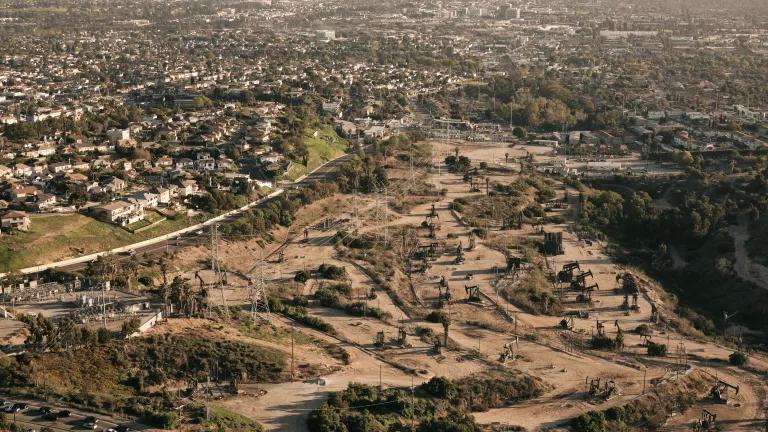Court: EPA Must Regulate Harmful Runoff Pollution in L.A.
A federal district court in Los Angeles has ordered the EPA to regulate harmful runoff pollution from commercial, industrial, and institutional sites in two Southern California watersheds.

Alamitos Bay Marina. Photo c/o City of Long Beach.
Last week a federal district court in Los Angeles ordered the U.S. Environmental Protection Agency (EPA) to regulate harmful runoff pollution from commercial, industrial, and institutional sites in two Southern California watersheds. These sites tend to have large amounts of impervious area—mainly in the form of parking lots and rooftops—which produce runoff containing high levels of contaminants whenever it rains.
The order follows EPA’s decision in 2016 to deny our petitions seeking regulation of stormwater runoff from these sites. The agency acknowledged that pollution from the sites contributes to violations of water quality standards, but it refused to regulate them anyway. Now a court has ruled that EPA’s decision was unlawful.
This ruling is a victory for the people and wildlife that call these watersheds home.
Runoff pollution contaminates Los Angeles waterways
The Dominguez Channel flows into the Los Angeles Inner Harbor. A million people live in the watershed, including many who use the Channel and the Harbor for recreation. The Harbor provides habitat for hundreds of species, including birds, sea lions, dolphins, and fish.
The Los Cerritos Channel begins as a concrete-lined channel before becoming a tidal estuary. It drains into the Alamitos Bay, and from there into the Pacific Ocean. The Channel is home to a marina and a popular fishing spot, and the watershed provides an overwintering site for many species of birds.
These waterways should be assets for the communities that live nearby. Yet they’re both legally designated as “impaired” because of high levels of toxic heavy metals like zinc and copper. That means they’re not clean enough to support aquatic life.
Stormwater runoff from commercial, industrial, and institutional sites contributes a significant percentage of this pollution. These sites tend to have large parking lots, rooftops, and other impervious surfaces that don't absorb water. When it rains, contaminated runoff from those surfaces flows directly into Dominguez Channel and Los Cerritos Channel—in most cases, without any treatment.
The Clean Water Act provides a solution
In order to tackle this ongoing problem, NRDC submitted petitions to EPA in 2015—along with co-plaintiffs American Rivers and Los Angeles Waterkeeper—asking the agency to require commercial, institutional, and industrial sites in these two watersheds to obtain discharge permits.
According to the federal Clean Water Act, if a category of stormwater discharges is contributing to water quality violations, EPA must exercise its “residual designation authority” and either prohibit those discharges or require the dischargers to apply for permits. If it chooses the latter approach, the permits must require the sites to limit the amount of pollution in their runoff, such as by mandating actions or steps that they must undertake.
For example, the permits could require the use of green infrastructure practices like rain gardens and green roofs, which capture rain where it falls. These practices not only reduce water pollution but also help to create healthier neighborhoods and improved quality of life in urban areas.
The law includes this requirement in order to ensure that all polluters do their fair share. If private stormwater dischargers get a free pass, that means municipalities—and local taxpayers—will bear the burden of cleaning up their mess.
But EPA has refused to take action
When EPA responded to our petitions, the agency agreed with us that the sites we identified are contributing to copper and zinc contamination in the two waterways. But it denied the petitions anyway, refusing to require the sites to reduce their pollution.
Instead, EPA wanted to rely on other regulatory approaches—approaches that aren’t working.

Stormwater outfall into Dominguez Channel. Photo c/o LA County Department of Public Works.
Specifically, the agency wanted to continue depending on local governments to clean up stormwater. But local governments don’t control the sites generating the runoff, and they haven’t done a good job dealing with this pollution in the past.
Municipal stormwater permits in these watersheds contain loopholes that make it less likely discharges will be controlled enough to meet water quality standards. And local governments charged with carrying out these duties are falling behind on implementation and developing weak clean-up plans.
By relying on these failing approaches, EPA abdicated its responsibility to hold polluters accountable.
That’s about to change.
A federal court has ordered EPA to regulate these dischargers
NRDC challenged EPA’s decision to deny our petitions in federal district court in Los Angeles. Yesterday, the court agreed with us and ruled that EPA’s actions violated the Clean Water Act.
The court came to this conclusion for two reasons.
First, it found that the Clean Water Act is clear about EPA’s duty to regulate. Once the agency has determined that stormwater discharges are contributing to water quality violations, the law gives EPA the choice to either subject them to permits or prohibit them, but it does not allow the agency to leave the discharges unregulated.
And second, the court found that EPA considered an improper factor when responding to our petitions. Congress did not intend for the agency to consider whether other programs are “adequately addressing” water quality problems when deciding whether to regulate stormwater sources. Instead, if EPA’s going to decline to issue permits, its reasons must relate to whether the stormwater at issue contributes to a violation of a water quality standard. Period.
NRDC will continue working to make sure EPA follows through on its duty to require permits for these sites or prohibit them from discharging, as well as pursuing our parallel case in Baltimore. We’re determined to achieve clean water for the communities affected by this pernicious source of pollution.




